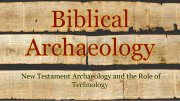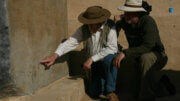Playback speed:
Introduction
In our previous post, we introduced the fascinating field of biblical archaeology and highlighted some significant discoveries that affirm the Bible’s historical reliability. Today, we delve deeper into ancient writings and historical documents that support the biblical narrative, focusing specifically on Old Testament archaeology. These ancient texts and findings validate the Biblical accounts and provide a broader historical context that enriches our understanding of the Scriptures.
Ancient Writings and Historical Records
Ancient manuscripts and historical records are more than just physical artifacts and structures. They are a treasure trove in Biblical archaeology. These texts, written by historians, scribes, and contemporaries of Biblical events, offer invaluable insights and external validation of the Biblical narrative. They leave us in awe of the depth of our historical knowledge and spark our curiosity for more.
The Merneptah Stele (circa 1208 BC):
This ancient Egyptian stele, discovered in Thebes, contains the earliest known reference to Israel outside the Bible. The inscription, commissioned by Pharaoh Merneptah, mentions a people called ‘Israel’ residing in Canaan, providing evidence of Israel’s presence in the region during the late 13th century BC. Learn more about the Merneptah Stele: Basil Library.
The Mesha Stele (circa 840 BC):
Also known as the Moabite Stone, this stele was found in Dhiban, Jordan. It contains King Mesha of Moab’s inscription detailing his victories over Israel, a narrative that aligns with the Biblical account of Moab’s rebellion against Israel described in 2 Kings 3. This stele, with its detailed account of the events, provides a strong external validation of the events described in the Old Testament, particularly the account of Moab’s rebellion against Israel. For more details on the Moabite Stone, visit the Biblical Archaeology Society.
The Babylonian Chronicles (circa 600-500 BC):
The Babylonian Chronicles, dating back to the 6th and 5th centuries BC, are a collection of ancient cuneiform tablets that chronicle the history of Babylon. These tablets contain events that align with the Biblical accounts of the Babylonian conquest of Judah and the exile of the Jewish people, providing substantial external evidence for the events described in the books of Kings, Chronicles, and Daniel, reinforcing our confidence in the historical accuracy of the Bible.
Archaeology and the Old Testament
The Old Testament is rich with historical events and figures that archaeological discoveries have substantiated. These findings not only affirm the Biblical narrative but also significantly enhance our understanding of the historical and cultural context of the ancient Near East, enriching our knowledge and appreciation of history.
The City of David:
Excitingly, ongoing excavations in Jerusalem have unearthed significant structures and artifacts from the First Temple period, including the remains of King David’s palace and the ancient water system described in 2 Samuel 5:8. These discoveries provide tangible evidence of Jerusalem’s importance during David’s reign, adding new layers to our understanding of history.
The Tel Dan Inscription:
As mentioned in our previous post, this stele references the ‘House of David.’ Discovered in northern Israel, it provides the earliest known extrabiblical evidence of King David’s dynasty, confirming the historical reality of his reign and the prominence of his lineage. Learn more about the Tel Dan Inscription on Biblical Archaeology Society.
The Hezekiah Tunnel:
This ancient water tunnel, known as the Hezekiah Tunnel, was carved during the reign of King Hezekiah, as described in 2 Kings 20:20 and 2 Chronicles 32:30. Discovered in Jerusalem, the tunnel served as a crucial defense measure during the Assyrian siege, a historical event described in the Old Testament. The Siloam Inscription within the tunnel provides a firsthand account of its construction. For more details, visit the Hezekiah Tunnel in HistoryHIT.
The Lachish Letters:
These ancient Hebrew inscriptions, discovered at the site of Lachish, date back to the Babylonian siege of Judah. The letters provide insights into the final days before the fall of Jerusalem, supporting the accounts of the Babylonian conquest described in the books of Kings and Jeremiah. Additional information on the Lachish Letters on Wikipedia and more in-depth links for further study can be found.
Conclusion
Ancient writings, historical documents, and archaeological discoveries offer compelling evidence supporting the Old Testament narrative. These findings not only validate the historical accuracy of the Bible but also provide a deeper understanding of the cultural and historical context in which these events occurred.
In our next post, we will explore New Testament archaeology and technology’s role in uncovering the New Testament’s historical context. We will examine the discoveries illuminating the life and times of Jesus and the early church, providing further evidence of the Bible’s authenticity.
Stay tuned as we continue our journey through the fascinating world of Biblical archaeology, where faith and history intersect to reveal profound truths about our ancient past.
For further reading:
Largest ever Second Temple era quarry discovered in Har Hotzvim Hi-Tech Park, Jerusalem (JPOST)





